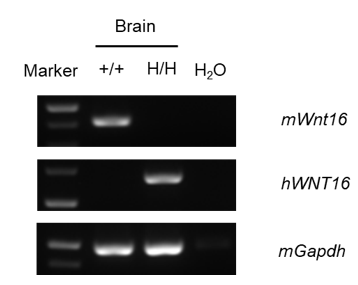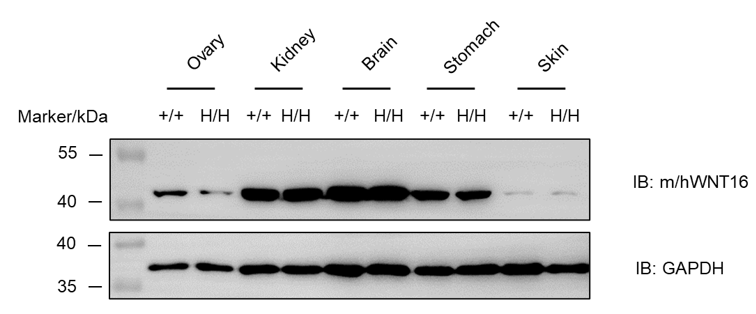


C57BL/6-Wnt16tm1(WNT16)Bcgen/Bcgen • 111010
| Product name | B-hWNT16 mice |
|---|---|
| Catalog number | 111010 |
| Strain name | C57BL/6-Wnt16tm1(WNT16)Bcgen/Bcgen |
| Strain background | C57BL/6 |
| NCBI gene ID | 93735 |
| Aliases | NA |

Strain specific analysis of WNT16 mRNA expression in wild-type C57BL/6 mice and B-hWNT16 mice by RT-PCR. Brain RNA were isolated from wild-type C57BL/6 mice (+/+) and homozygous B-hWNT16 mice (H/H), then cDNA libraries were synthesized by reverse transcription, followed by PCR with mouse or human WNT16 primers. Mouse Wnt16 mRNA was detectable in wild-type C57BL/6 mice and homozygous B-hWNT16 mice. Human WNT16 mRNA was detectable only in homozygous B-hWNT16 mice but not in wild-type mice.

Western blot analysis of WNT16 protein expression in homozygous B-hWNT16 mice. Various tissue lysates were collected from wild-type C57BL/6 mice (+/+) and homozygous B-hWNT16 mice (H/H), and then analyzed by western blot with anti-WNT16 antibody (Abcam, ab109437). 40 μg total proteins were loaded for western blotting analysis. WNT16 was detected in ovary, kidney, brain, stomach and skin in wild-type mice and homozygous B-hWNT16 mice, as the antibody is cross-recognize both human and mouse WNT16.